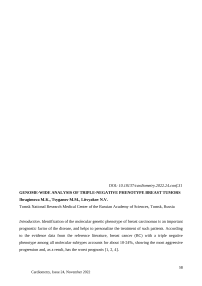Genome-wide analysis of triple-negative phenotype breast tumors
Автор: Ibragimova M.K., Tsyganov M.M., Litvyakov N.V.
Журнал: Cardiometry @cardiometry
Статья в выпуске: 24, 2022 года.
Бесплатный доступ
Introduction. Identification of the molecular genetic phenotype of breast carcinomas is an important prognostic factor of the disease, and helps to personalize the treatment of such patients. According to the evidence data from the reference literature, breast cancer (BC) with a triple negative phenotype among all molecular subtypes accounts for about 10-24%, showing the most aggressive progression and, as a result, has the worst prognosis.
Короткий адрес: https://sciup.org/148326324
IDR: 148326324 | DOI: 10.18137/cardiometry.2022.24.conf.31
Текст статьи Genome-wide analysis of triple-negative phenotype breast tumors
Tomsk National Research Medical Center of the Russian Academy of Sciences, Tomsk, Russia
Introduction . Identification of the molecular genetic phenotype of breast carcinomas is an important prognostic factor of the disease, and helps to personalize the treatment of such patients. According to the evidence data from the reference literature, breast cancer (BC) with a triple negative phenotype among all molecular subtypes accounts for about 10-24%, showing the most aggressive progression and, as a result, has the worst prognosis [1, 2, 4].
The aim of the presented study was to conduct a genome-wide analysis of breast cancer with a triple negative molecular subtype (TN BC).
Material and methods . Our study included 25 patients with a morphologically verified diagnosis of TN BC, mean age 47.6±0.4 years. Prior to treatment, DNA from tumor biopsy material was isolated using the QIAamp DNA mini Kit (Qiagen, Germany). In order to evaluate the CNA landscape, we utilized the CytoScan HD Array (Affymetrix, USA) microarray. For the purpose of the bioinformatics analysis, the Chromosome Analysis Suite 4.0 software was applied.
Results . The largest number of amplifications (more than 64.0%) (in the absence of deletions) was found in the 1q21.3 locus. The highest rate of deletions (more than 56.0%) was found in loci 3p21.31, 3p21.2, 3p21.1 (in the absence of amplifications) and in locus 17q11.2. As a result from comparing the rates of the CNA incidence in groups of patients, depending on the presence/absence of an objective response to neoadjuvant chemotherapy (NCT) in them, it was shown that the presence of an objective response to preoperative chemotherapy was observed in case with a greater number of amplifications in the 3q23 region (p = 0.03). Potentially, this locus can be considered as a predictive marker of a good response to NCT in the TN BC patients. As a result from the comparison of the CNA incidence rates in groups of patients with the presence / absence of hematogenous metastasis, it was shown that the presence of hematogenous metastasis was observed in case with a greater number of the amplifications in the 5p14.2 region (p = 0.018) and with a greater number of the deleted regions in the 4q26 region (p =0.04).
Discussion . Already more than 10 years ago, Mersin et al detected that patients with TN BC had a higher risk of recurrence, with its average time slightly exceeding 1 year [3]. To date, searching for markers to predict the course of the disease as well as identification of an approach to prevent the recurrence and metastasis is crucial for improving the survival of patients with TN BC [5].
Conclusions . We assessed the genetic response of TN BC to NCT and the association with distant metastases. In the future, such data can form the basis for the development of new markers of the treatment effectiveness for patients with triple-negative phenotype breast cancer.
Список литературы Genome-wide analysis of triple-negative phenotype breast tumors
- Derakhshan F, Reis-Filho JS. Pathogenesis of Triple-Negative Breast Cancer. Annual Review of Pathology: Mechanisms of Disease. 2022; 17(1):181-204. 10.1146/annurev-pathol-042420- 093238.
- Lee K-L, Kuo Y-C, Ho Y-S, Huang Y-H. Triple-Negative Breast Cancer: Current Understanding and Future Therapeutic Breakthrough Targeting Cancer Stemness. Cancers. 2019; 11(9): 1334. -.
- Mersin H, Yildirim E, Berberoglu U, et al. The prognostic importance of triple negative Breast carcinoma. Breast. 2008; 17:341-346.
- Qiu J, Xue X, Hu C, et al. Comparison of clinicopathological features and prognosis in triplenegative and non-triple negative breast cancer. J Cancer. 2016; 7(2): 167-173.
- Yang C-Q, Liu J, Zhao S-Q, et al. Recent treatment progress of triple negative breast cancer. Progress in Biophysics and Molecular Biology 2020; 151:40-53.


